Looking for new ways to target your LinkedIn ads delivery? Wondering how to align your audience targeting with your prospects’ interests?
In this article, you’ll learn how to use interest targeting to improve your LinkedIn advertising outcomes.
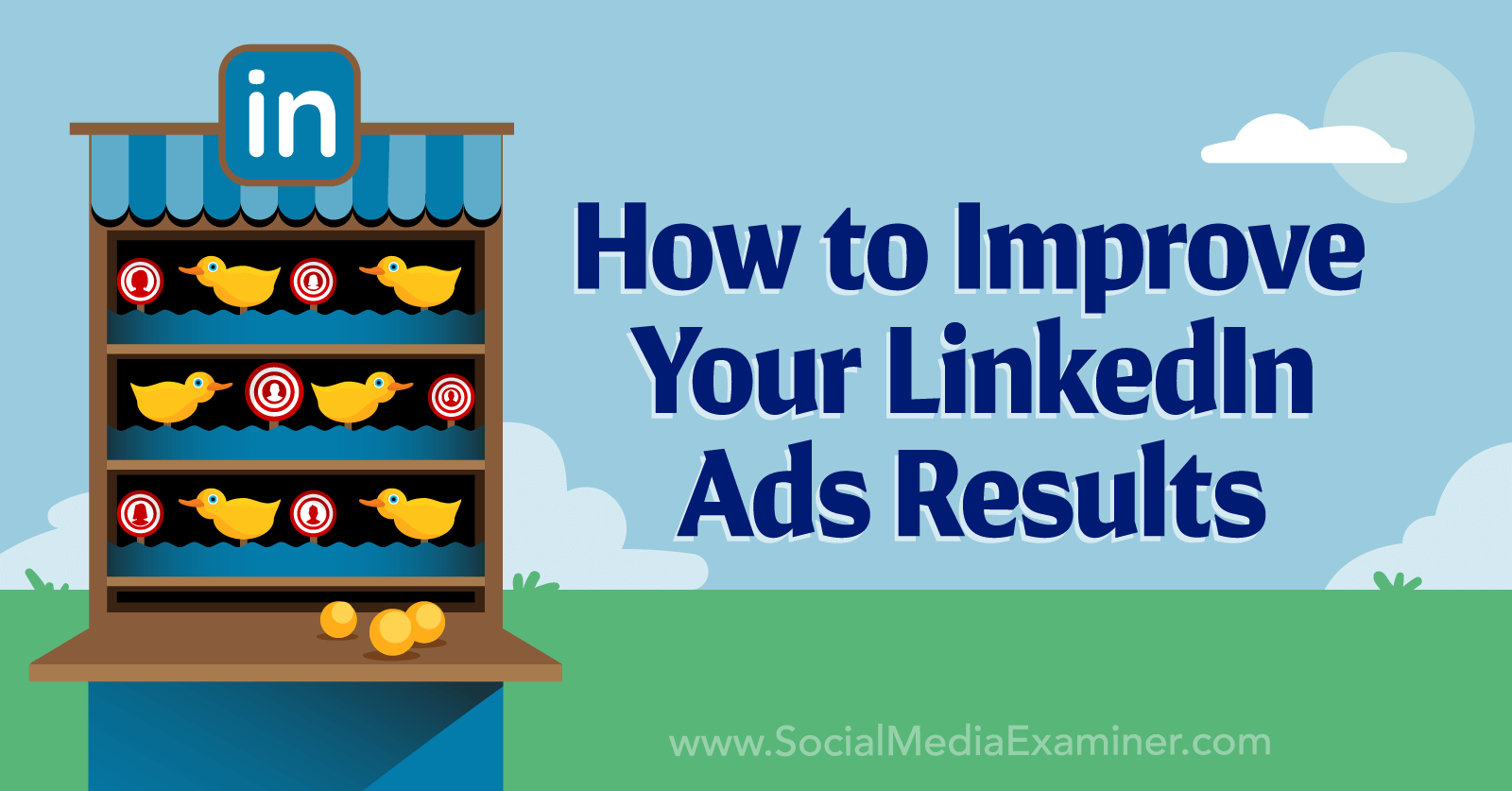
Why Marketers Should Care About LinkedIn Ads Interest Targeting
If your LinkedIn advertising strategies tend to focus on account-based marketing (ABM) or connecting with decision-makers in specific verticals, you may ignore interest-based targeting criteria in favor of focusing on company or job experience attributes. But as helpful as job- and company-based targeting can be, these options aren’t always enough to help you reach the right audiences.
Interest targeting lets you tap into the problems your prospects are dealing with so you can respond with relevant solutions. If your LinkedIn campaigns use solution-focused messaging, interest targeting can help you get your promoted content in front of B2B decision-makers whose needs align with your offer.
For years, LinkedIn has offered general interest targeting, which lets advertisers reach members based on the professional topics they engage with. Until recently, the advertising platform has had relatively limited options for reaching audiences based on product and service categories.
In early 2023, however, LinkedIn introduced more than 120 product interest attributes and more than 20 service interest attributes. Now advertisers have more than 400 interest categories to choose from while building and fine-tuning target audiences.
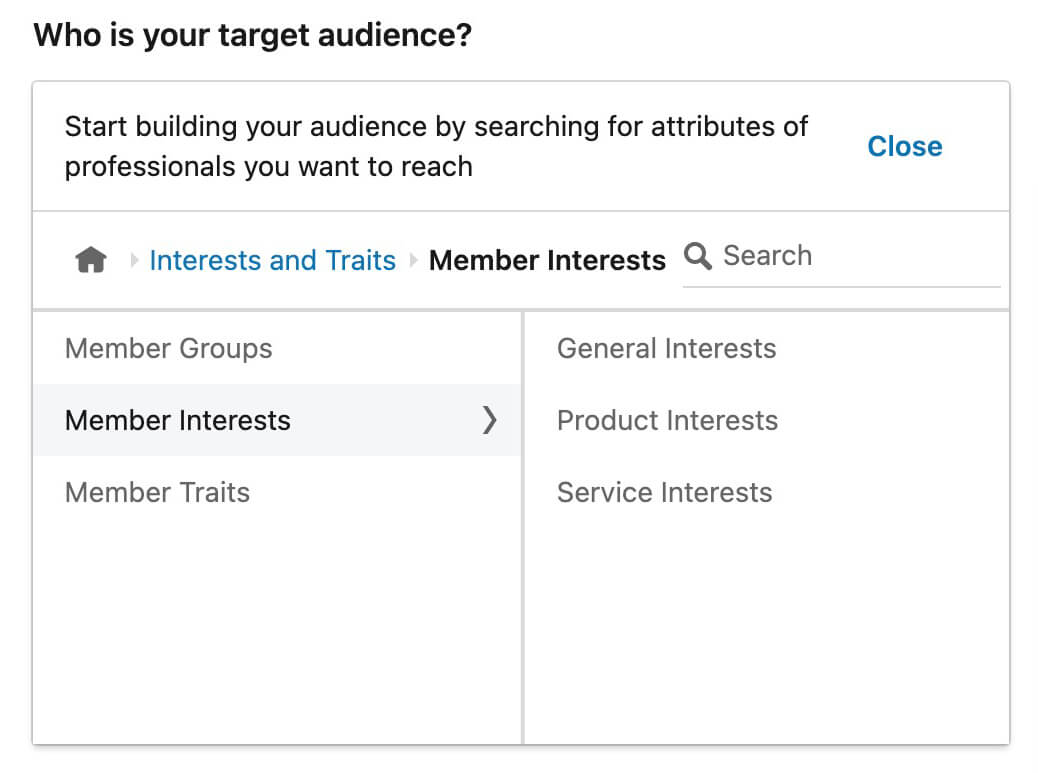
Depending on your campaign objectives and messaging, LinkedIn’s interest targeting criteria may be sufficient for reaching your ideal customer. But in many cases, these targeted options work better when layered with company- and job experience–based attributes, essentially leveling up ABM and other campaigns throughout the funnel.
How to Use 3 Types of LinkedIn Ads Interest Targeting
LinkedIn Campaign Manager now offers three types of interest targeting. All three are available at the campaign level for every objective, and you can also access them in LinkedIn’s Audiences Manager on the Saved tab. Let’s walk through the options.
General Interest Targeting
Using general interest targeting, you can connect with decision-makers who’ve engaged with various industry topics. For example, you can get your content in front of people who have searched for business and management topics or commented on posts related to careers and employment.
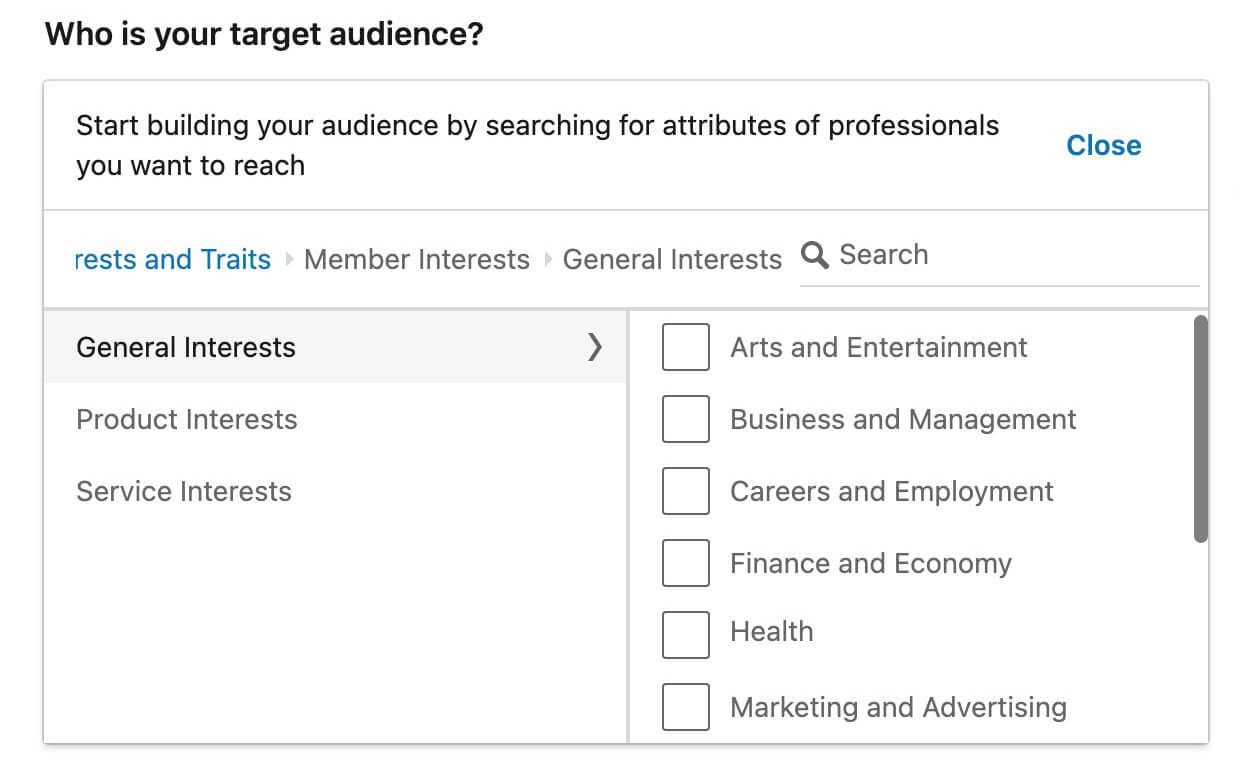
Campaign Manager lists about a dozen broader general interest categories, which can be ideal if you want to cast a wide net. If you want to reach an audience with more specific interests and needs, however, click any of the broader general interest categories to view relevant subtopics.
For example, rather than targeting members with an interest in marketing and advertising, you can focus on those with an interest in more nuanced topics like brand management or digital marketing instead.
Note that many general interest categories have multiple levels of subtopics. For example, rather than targeting people with a broad interest in marketing strategies, you can focus on those with an interest in lead generation or media planning.
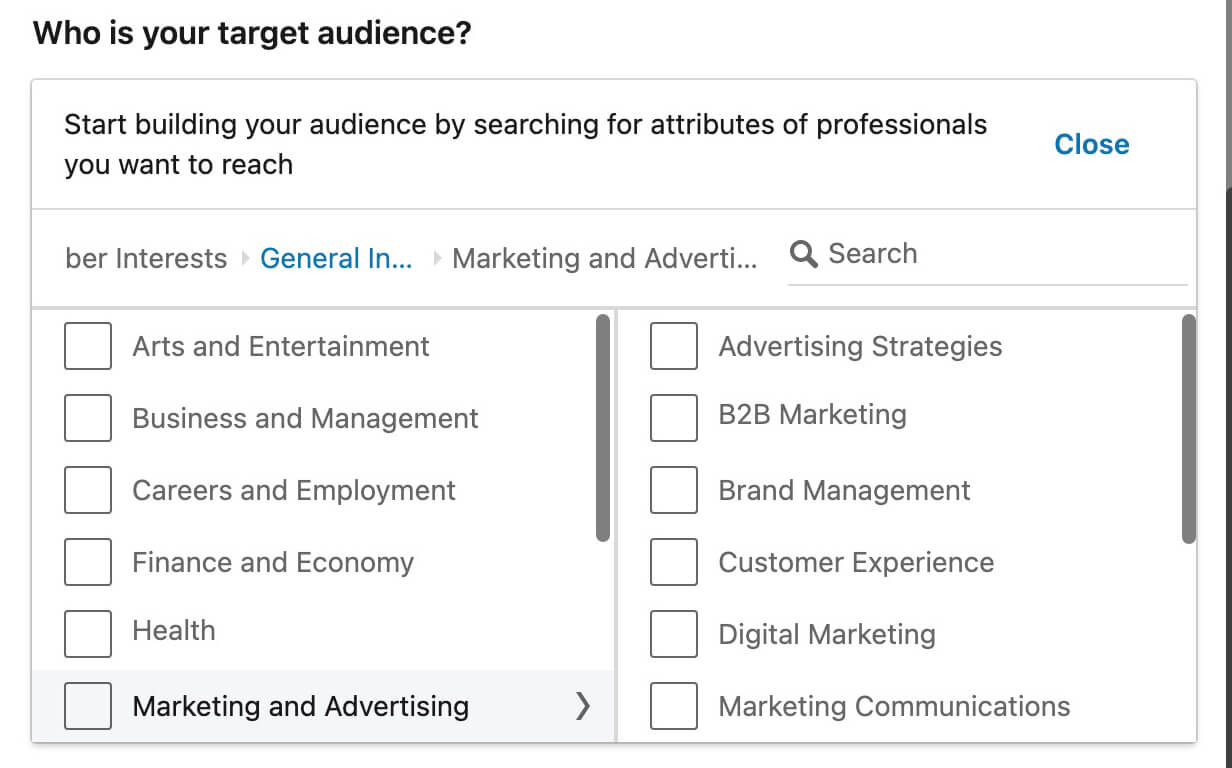
Hover over any of the options at any level to see an estimate of the number of LinkedIn members you may be able to reach by targeting the interest. Keep in mind that many of the high-level general interest categories have large audience estimates that don’t allow very specific targeting.
For example, the broad marketing and advertising general interest category has an estimated audience size of over 310 million members in the United States. Two levels deeper, the lead generation category has an estimated audience size of just 14 million members. Keep these differences in mind to optimize audiences for your campaigns.
Get World-Class Marketing Training — All Year Long!
Are you facing doubt, uncertainty, or overwhelm? The Social Media Marketing Society can help.
Each month, you’ll receive training from trusted marketing experts, covering everything from AI to organic social marketing. When you join, you’ll also get immediate access to:
- A library of 100+ marketing trainings
- A community of like-minded marketers
- Monthly online community meetups
- Relevant news and trends updates
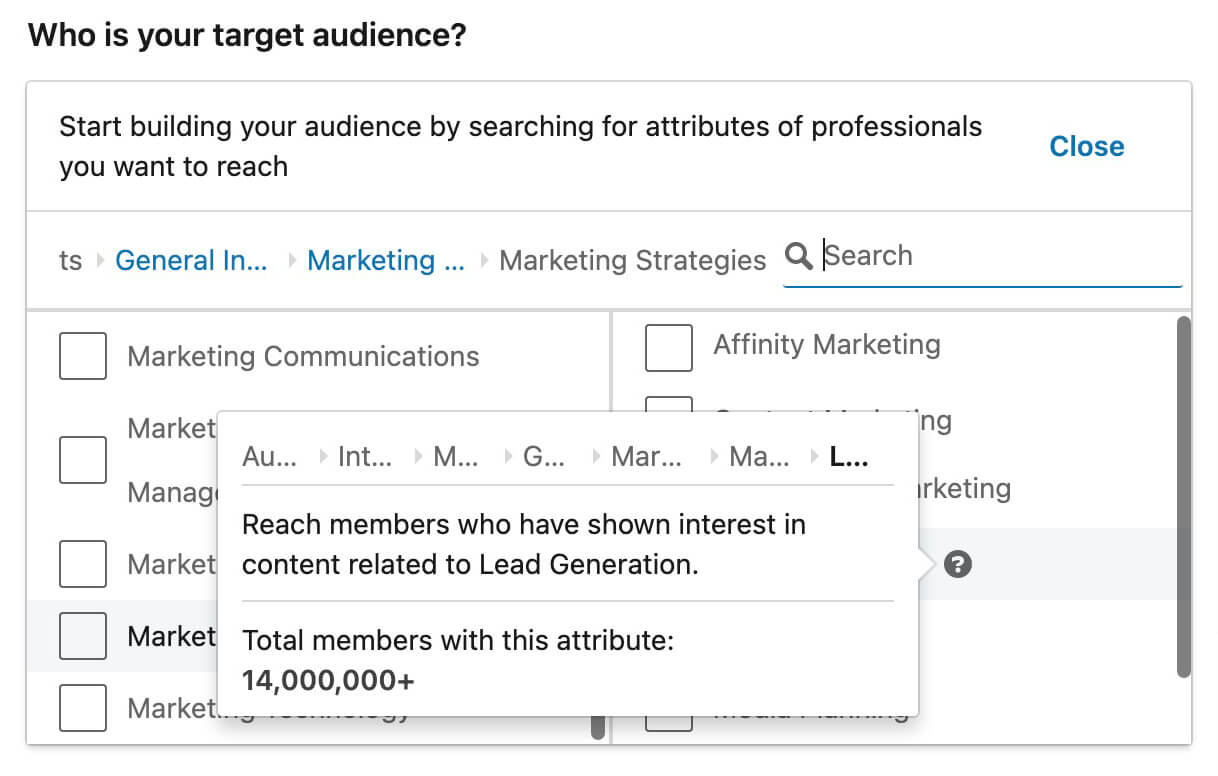
Product Interest Targeting
Software-as-a-service (SaaS) marketers in particular may potentially get a ton of value from LinkedIn’s product interest targeting. Because this type of targeting focuses on software products, it’s ideal for getting your content in front of B2B decision-makers seeking apps and enterprise tools to meet their teams’ needs.
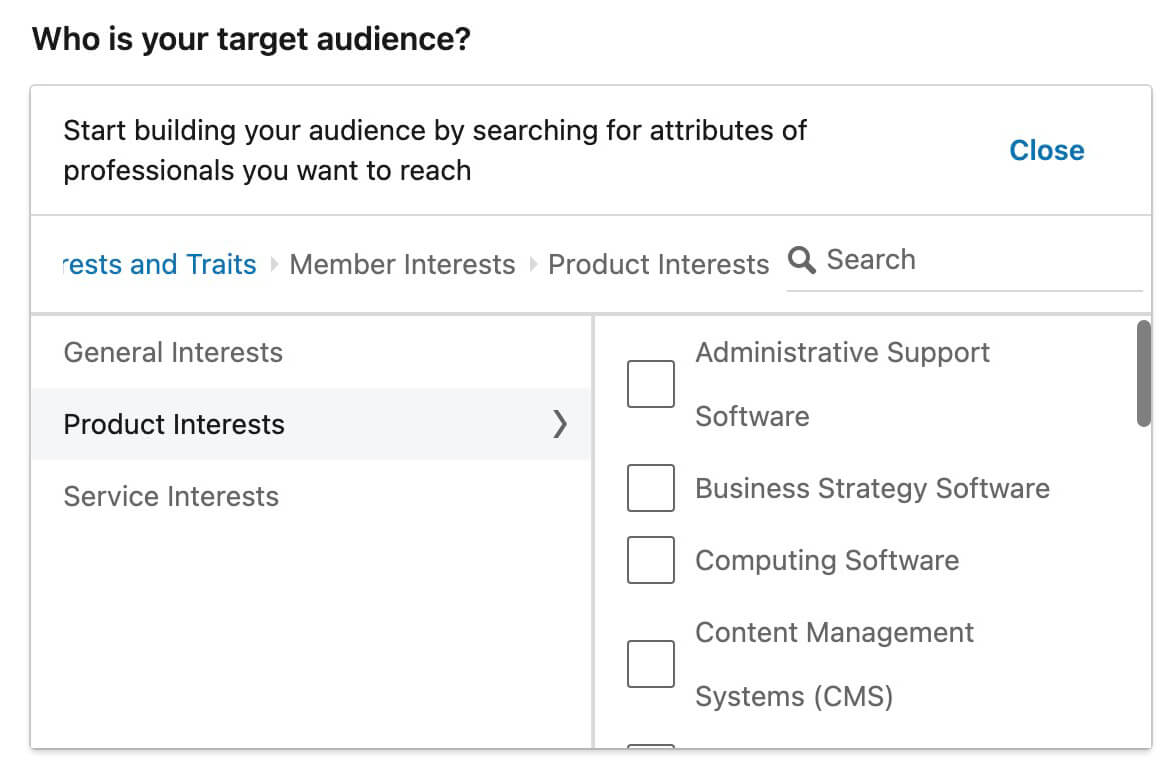
By using this targeting option, you can reach members who have engaged with relevant software products by searching LinkedIn, creating content about them, or reacting to posts about them. For example, this targeting can help you reach decision-makers who are asking questions about these products or looking for recommendations.
Similar to Campaign Manager’s general interest targeting, the platform’s product interest targeting has several sublevels. The broadest targeting level features about 20 software categories, including content management systems and productivity software.
If you’re planning to run top-of-funnel campaigns geared toward decision-makers who are just beginning their software buying journey, these broader product interest categories could be a good choice. Consider using them with LinkedIn’s brand awareness objective.
However, keep in mind that even the broadest product interest categories are much smaller than the general interest categories we covered above. Hover over any of the categories on the list to check the estimated audience size.
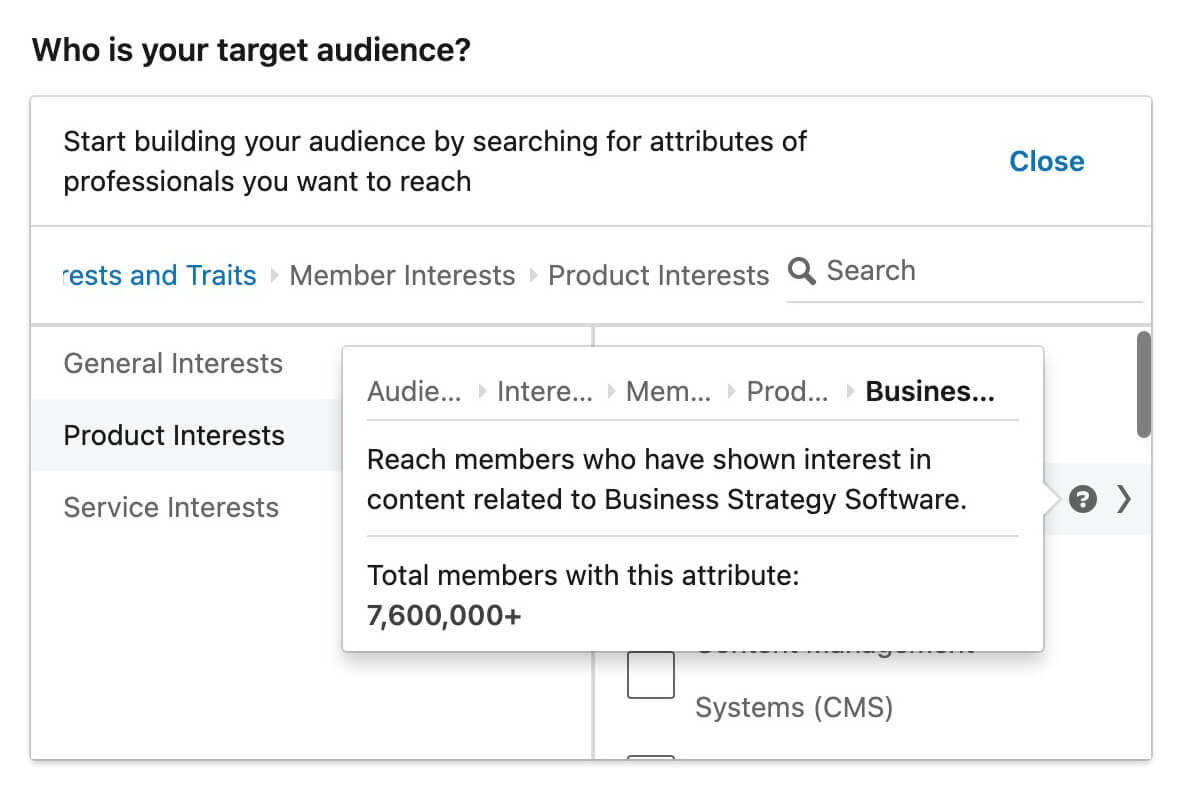
To target LinkedIn members with more specific needs, explore the product interest subcategories. For example, rather than targeting B2B decision-makers interested in sales software, target those with an interest in sales engagement platforms.
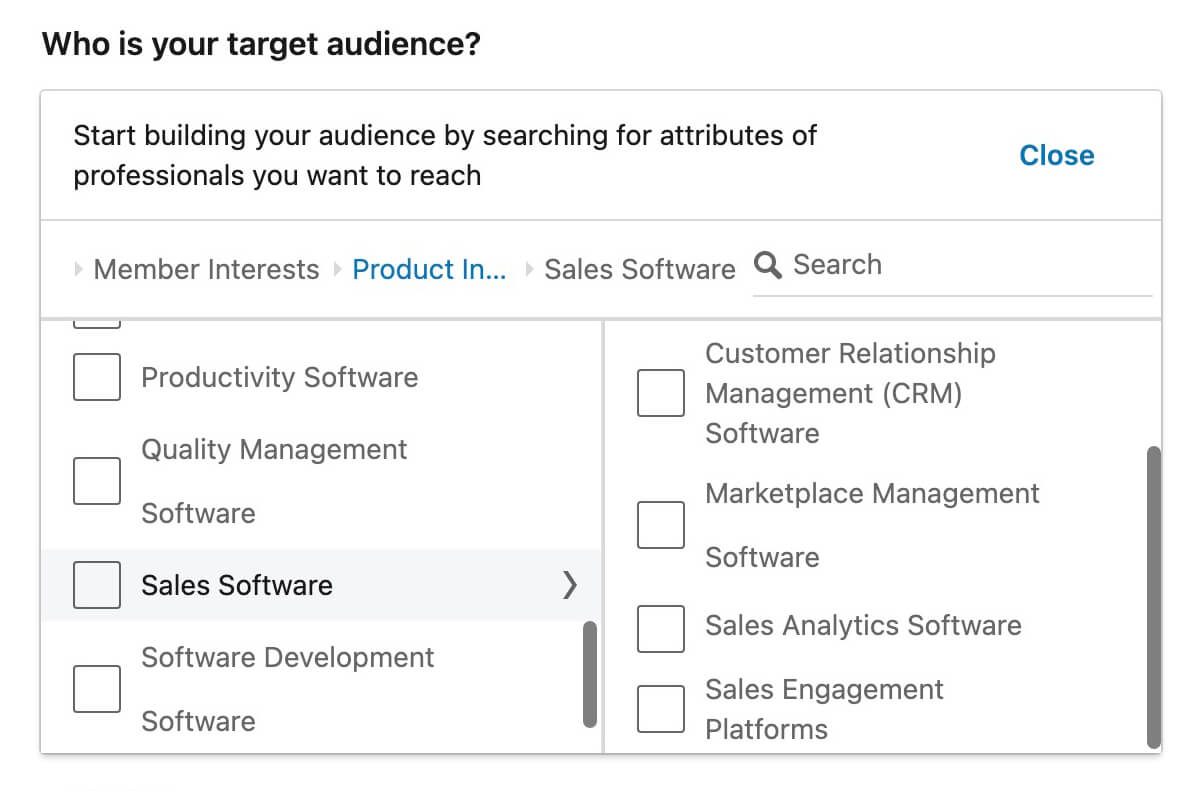
Pay close attention to the estimated audience sizes for these subcategories, especially if you’re building a campaign you plan to scale. Some of these include 10 million or more users but many niche products have estimated audiences of fewer than 1 million.
Service Interest Targeting
Service providers are uniquely positioned to get value from Campaign Manager’s service interest targeting options. A completely new type of interest targeting for LinkedIn, this option lets you reach B2B decision-makers seeking certain types of vendors or agencies.
Campaign Manager offers about two dozen service interests, ranging from business consulting and marketing services to interior design and real estate services. But unlike the other two types of interest targeting, service interests don’t have multiple subcategories.
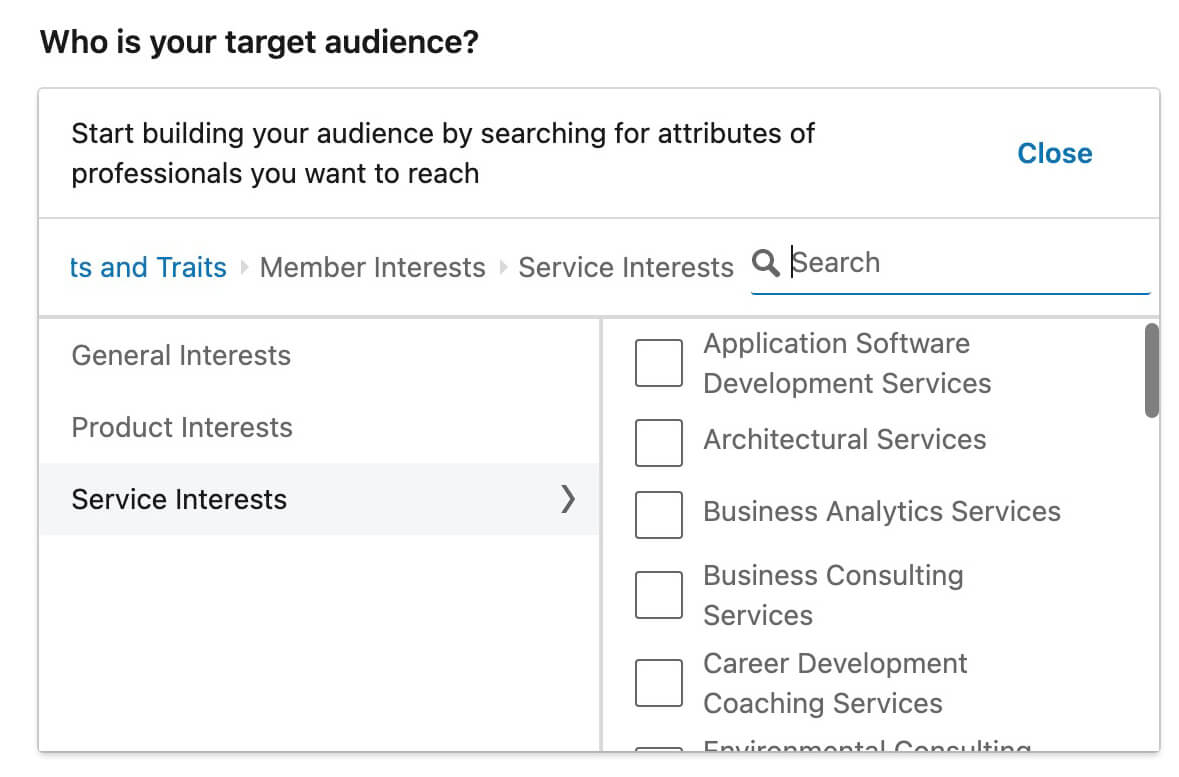
That’s because LinkedIn’s service interests have significantly smaller estimated audiences. Many include fewer than 1 million people, and some include fewer than 100,000 people. If you use these audiences, be sure to avoid adding multiple other targeting layers, as the resulting audience is likely to be too small for efficient delivery.
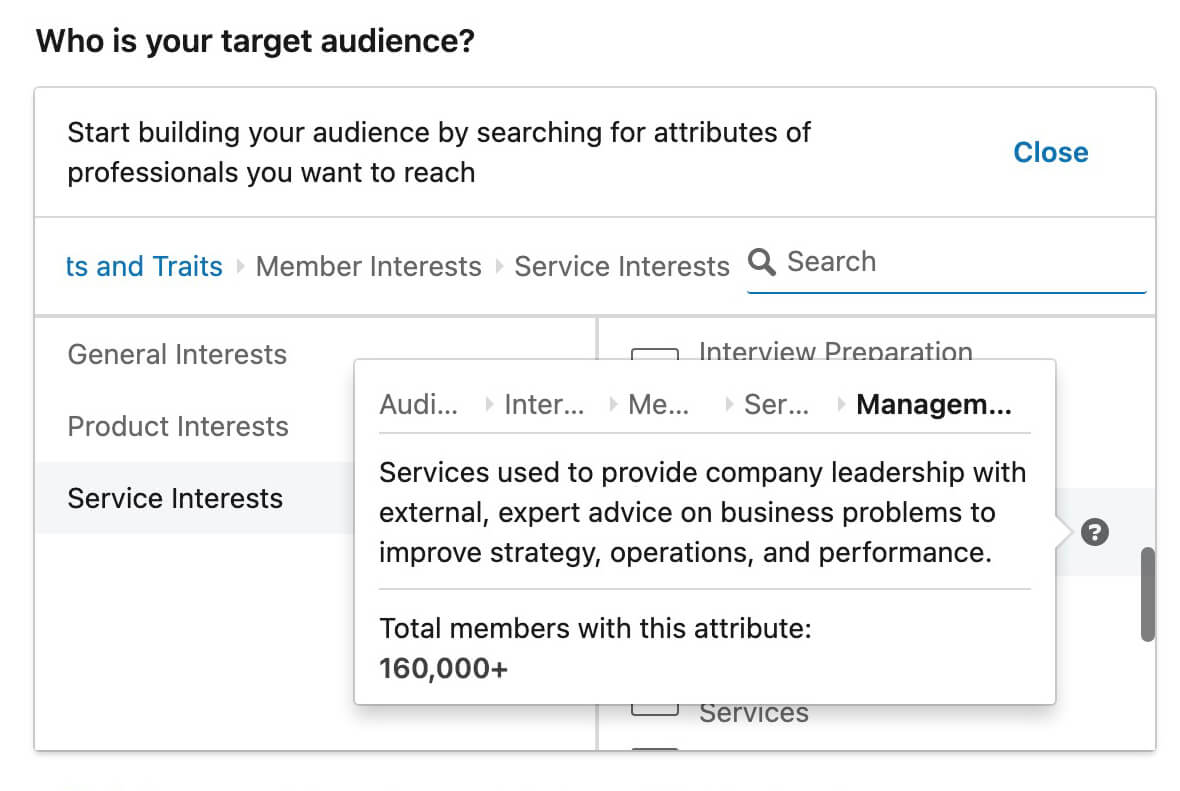
6 Ways to Optimize LinkedIn Ads Interest Targeting
Now you have a sense of how LinkedIn’s expanded interest targeting works. Let’s look at how to implement it in LinkedIn ad campaigns.

Discover Proven Marketing Strategies and Tips
Want to go even deeper with your marketing? Check out the Social Media Marketing Podcast! Publishing weekly since 2012, the Social Media Marketing Podcast helps you navigate the constantly changing marketing jungle, with expert interviews from marketing pros.
But don’t let the name fool you. This show is about a lot more than just social media marketing. With over 600 episodes and millions of downloads each year, this show has been a trusted source for marketers for well over a decade.
#1: Align Audience Interests With Awareness Levels
Whether you’re selling a product or a service, you need ad campaigns that speak to your audience’s awareness levels. Otherwise, your messaging is likely to fall flat and lead to poor engagement and conversion rates.
Where does your audience stand in their awareness journey? They may be:
- Problem-aware, meaning they know they’re dealing with a challenge but they haven’t begun looking for solutions yet. This stage fits best with general interest targeting, especially if you use problem-focused messaging that gets attention and sparks curiosity.
- Solution-aware, meaning they know how to resolve their challenge but they either haven’t prioritized finding a solution or don’t know your product yet. This stage can work with either general interest or product and service interest targeting, as long as you use problem-focused messaging to position your solution.
- Product- (or service-) aware, meaning they know about your offer but haven’t chosen it as their preferred solution yet. This stage works well with product or service interest targeting and solution-focused messaging that highlights your brand.
For example, say you’re running ads for a marketing agency that specializes in branding. To reach problem-aware prospects, you can use general interests like brand management.
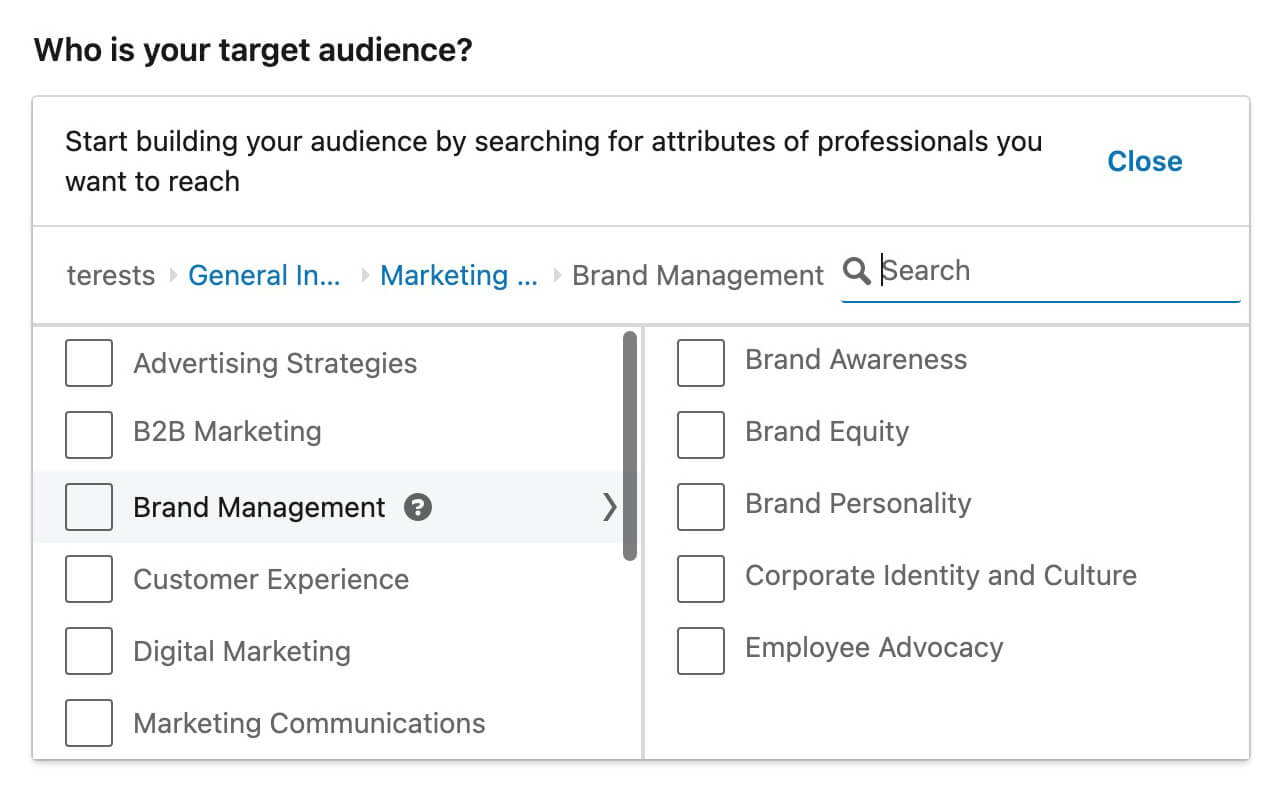
When targeting the solution- and service-aware stages, you can use service interests like marketing services.
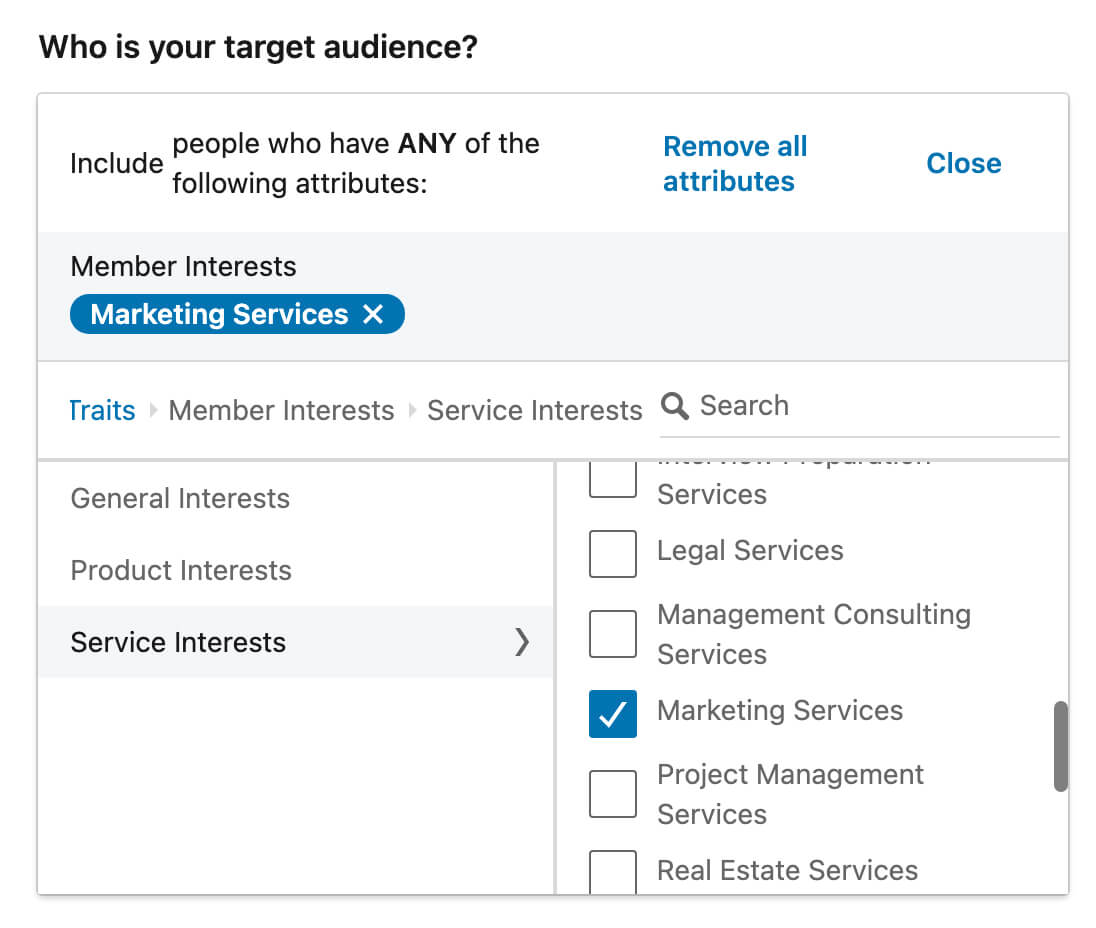
#2: Test Broader Interests for Viability
In many cases, you’ll find multiple interest targeting options that are relevant to your campaign. How do you know which to add to your campaigns?
It’s often best to start by targeting broader interest categories, especially if you’re running top-of-funnel campaigns geared toward problem-aware prospects. With broader targeting, you can reach larger audiences, which gives you more opportunities to introduce your brand and improve awareness.
For example, say you want to advertise a new artificial intelligence (AI) tool. If you use the AI general interest category, you can reach an estimated audience of 100 million (in the United States).
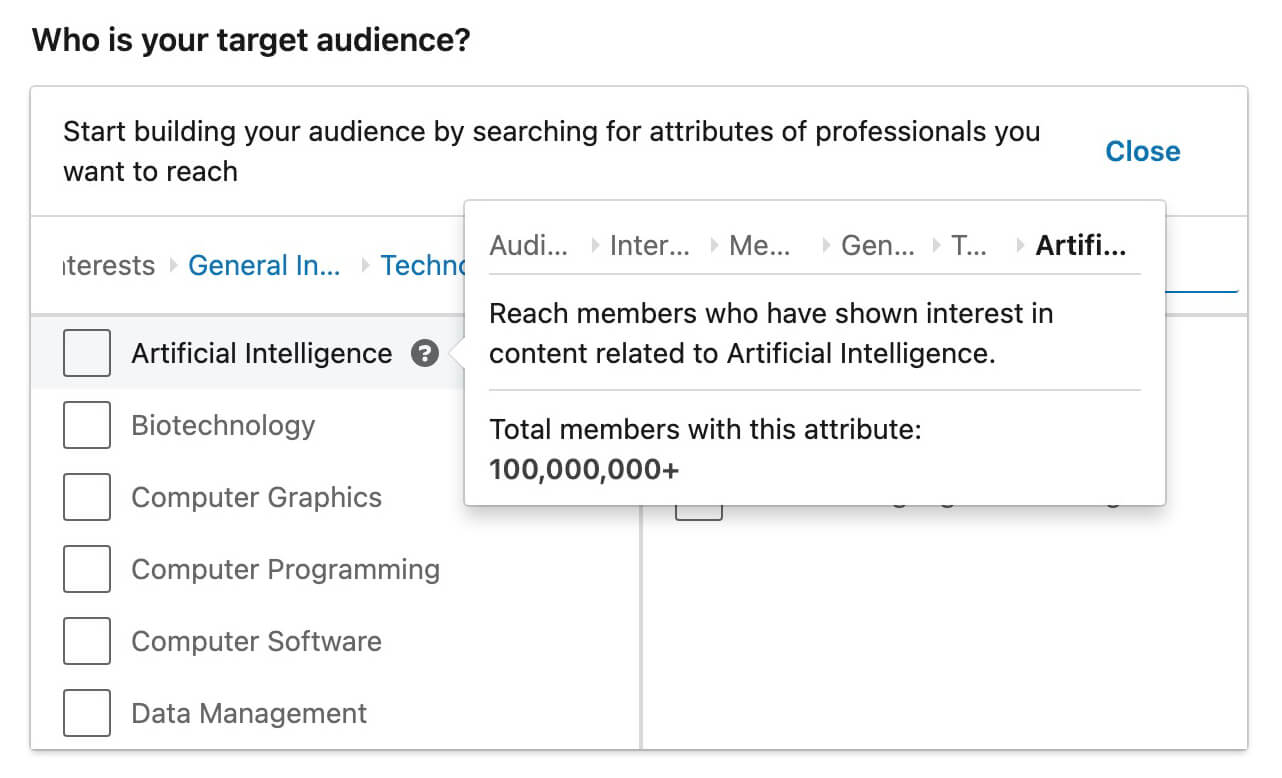
That’s about twice the size of the audience you’d reach by targeting the machine learning subcategory (45 million) or the natural language processing subcategory (61 million).
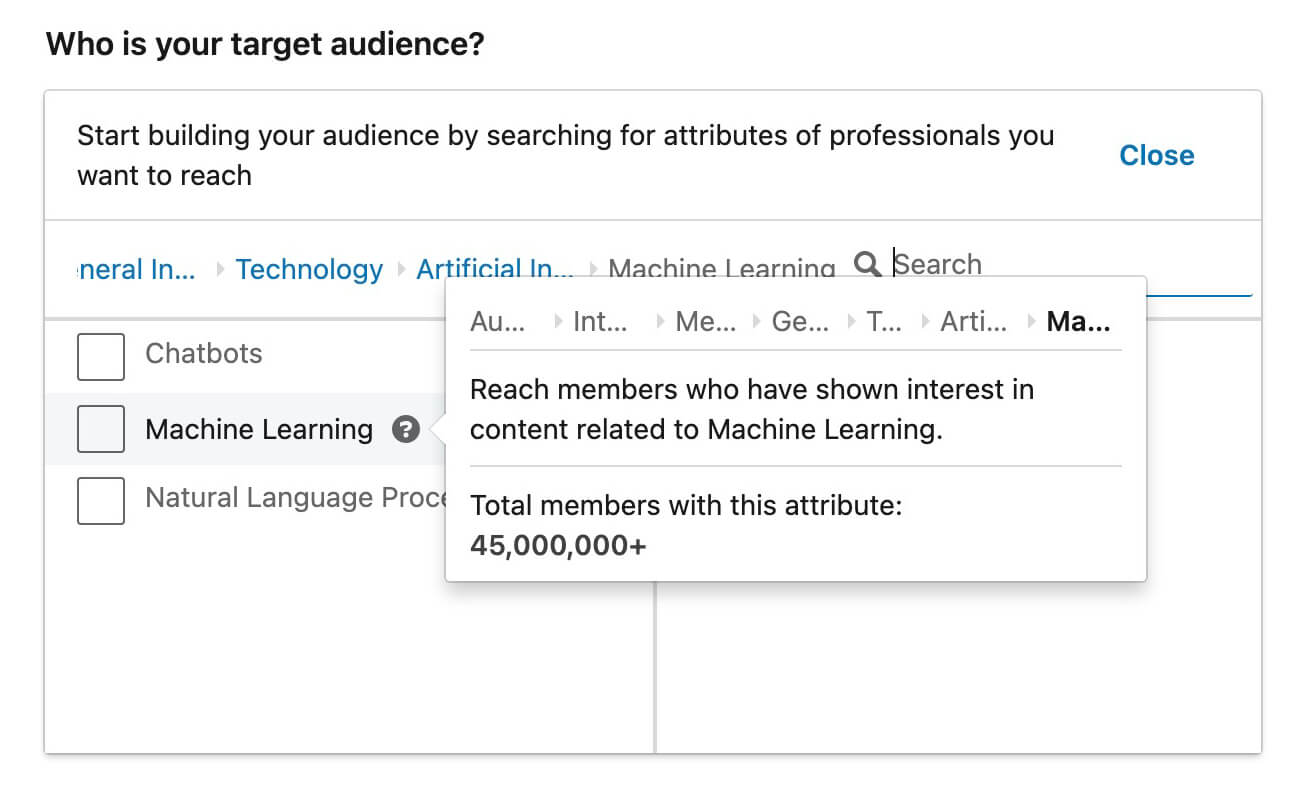
Using broader interests also allows you to test larger audiences for viability. For example, you might test a campaign that targets the AI general interest category. If it delivers good results, you might consider zeroing in on a relevant subcategory like ML or NLP.
#3: Separate Interest-Based Audiences by Campaign
Testing different targeted options is a smart way to optimize LinkedIn advertising campaigns. But if you group all of your interest-based audiences into a single campaign, you’ll have a hard time identifying which one is driving the best results.
That’s why it’s best to separate interest-based audiences into unique campaigns under a single campaign group. With this type of campaign structure, you can essentially run A/B tests that definitively identify the top-performing target audience for your offer.
Once you’ve found the winning interest targeting option, you can shut off the other campaigns or modify their targeting for further testing. Then you can scale the winning campaign (see below).
#4: Combine Interests With Complementary Targeting
Interest targeting can be great for reaching potential customers with problem-based messaging. But in most cases, your target market probably won’t include absolutely everyone who engages with the interests you select.
To find your ideal customer, add member traits to your target audience. For example, say you want to promote a customer relationship management (CRM) tool to B2B decision-makers. You can select CRM software from the product interest list and pick relevant options from the job seniorities list such as VP and director.
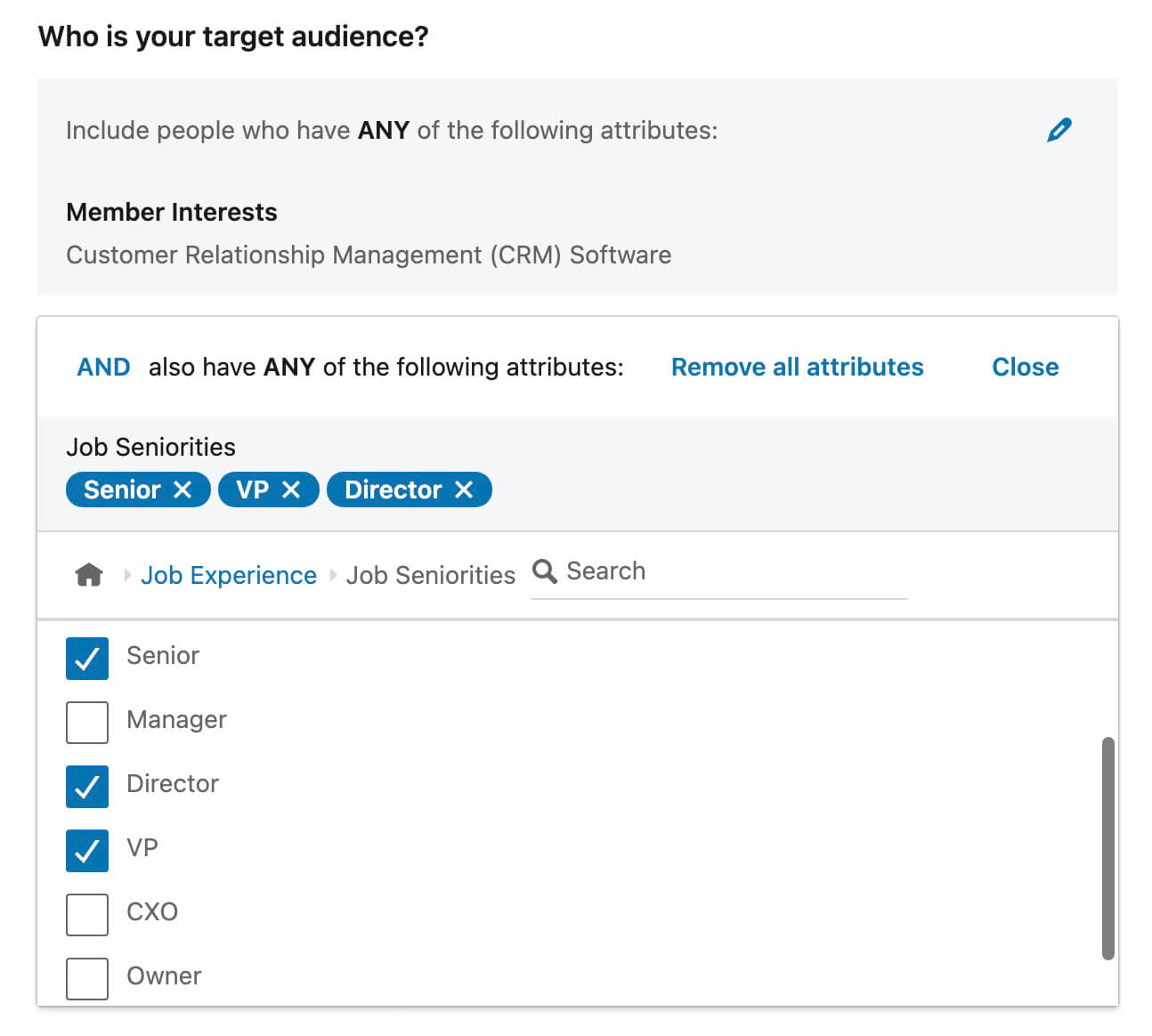
When you combine interests with other targeting types, pay close attention to the logical structure of the audience. The example above uses the Narrow function to include people who have both an interest in CRM software and a relevant job seniority.
Keep in mind that it’s best to avoid using the Narrow function multiple times while creating an audience. As you build your audience, watch Campaign Manager’s forecasted results closely to make sure the audience is large enough to serve efficiently. LinkedIn recommends audience sizes of at least 50,000, but for efficient delivery, you typically need to aim for a much bigger audience.
#5: Make a Plan to Scale Campaigns With Interest Targeting
Once you’ve run some audience targeting tests, you’ll have a much better idea of what works and what doesn’t for your LinkedIn ad campaigns. That means you can start fine-tuning your audiences and scaling your results.
If you have the budget for it, vertical scaling is the most effective way to grow an ad campaign. Naturally, increasing the daily or lifetime budget of a successful campaign can help drive more results.
But if increasing the budget isn’t an option or you need to expand your audience instead, focus on horizontal scaling. Enabling audience expansion is the easiest way to scale horizontally but it doesn’t give you much control over who you reach.
Instead, find and add new audience segments manually. In most cases, it’s best to test new ad targeting options before adding them to an optimized campaign, especially if you’re thinking about adding a trending topic to the list of interests.
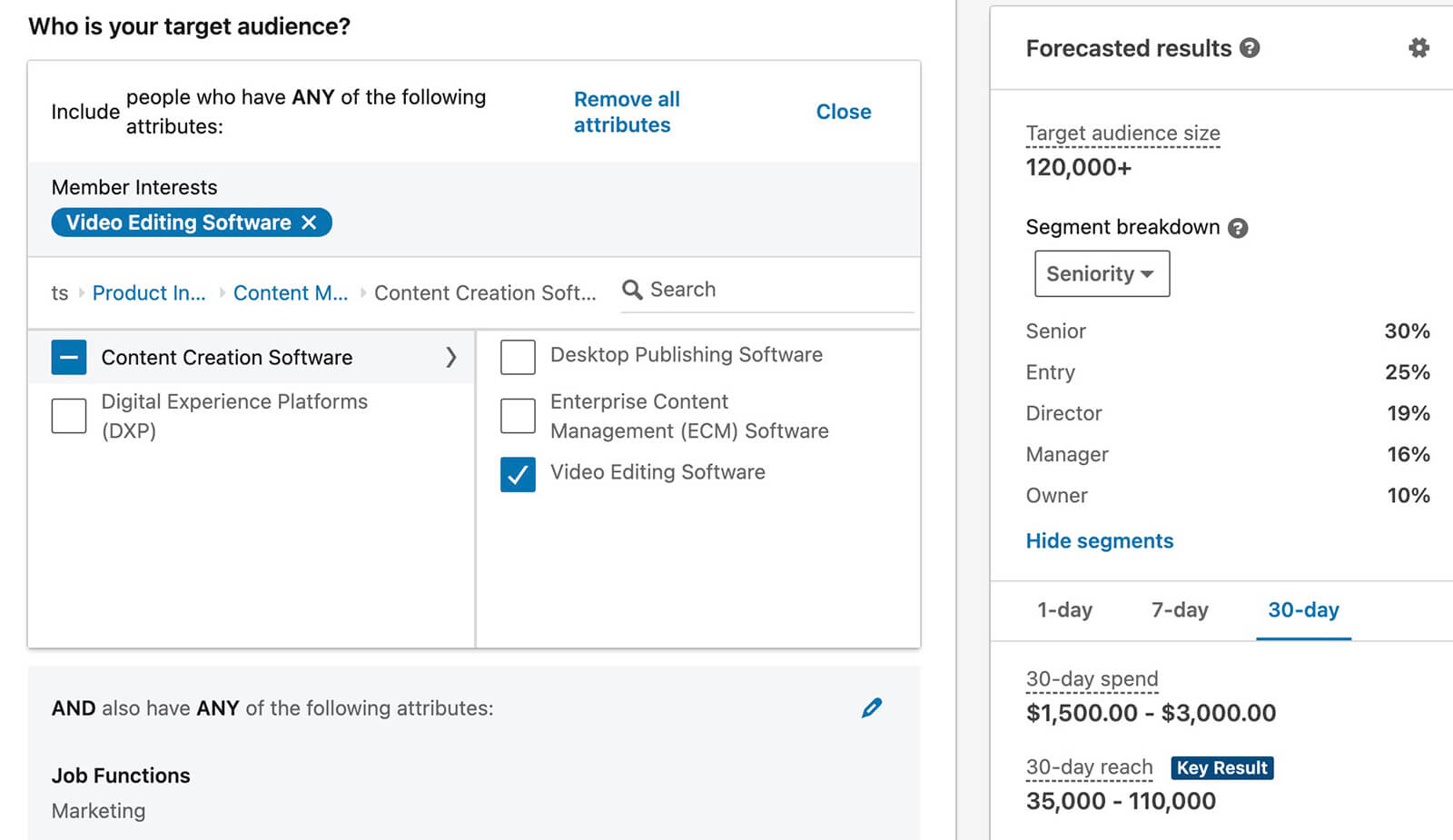
To scale interest targeting horizontally, add more related interests to a campaign or broaden the interest targeting you’ve already applied. If you’ve added member traits to the campaign, consider adding more related options or broadening those as well.
As you modify the target audience, monitor the forecasted results, especially the segment breakdown. Use the drop-down menu to evaluate seniority, function, and other factors. Before publishing a scaled audience, make sure it matches the types of B2B buyers you need to reach.
If the added interests or traits skew the audience in the wrong direction, consider using Campaign Manager’s exclusion options. For example, you can exclude certain roles or seniority levels to avoid wasting ad spend on the wrong audience.
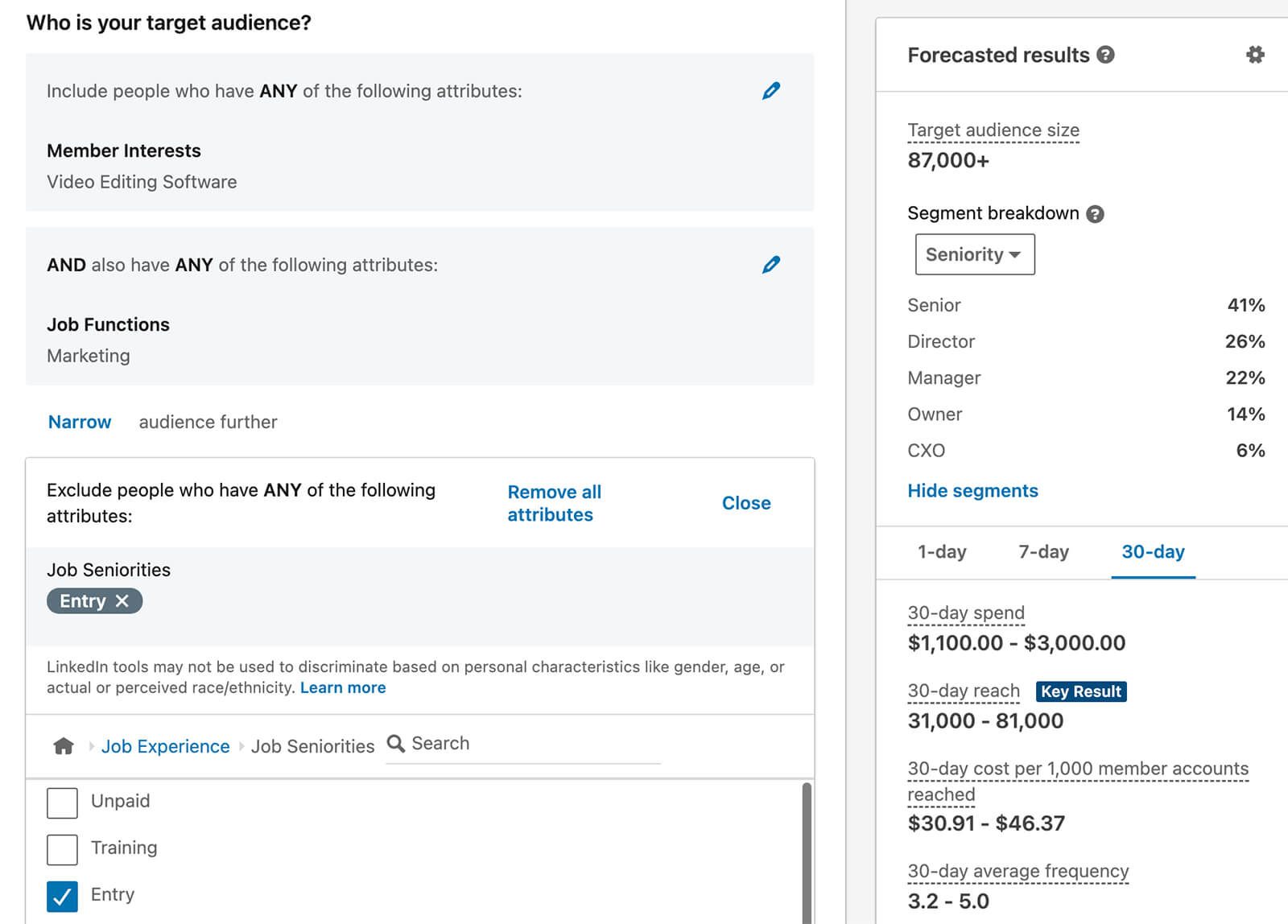
#6: Know When Interest Targeting Isn’t the Best Option
Member interests can be versatile audience ad targeting options; however, they aren’t ideal for every campaign. For example, if you’re planning to retarget warm leads, you don’t need interest targeting. Adding it may have the unintended effect of eliminating some of your best prospects from your audience.
In addition, interest targeting is incompatible with some targeting options. Campaign Manager won’t allow advertisers to use interest targeting with a list upload or website retargeting audience.
To optimize list uploads and retargeting lists, segment them before using them to create audiences in Campaign Manager. That way, you can ensure you’re only reaching your most qualified prospects, avoid wasting ad budget on unqualified prospects and improve LinkedIn ads overall.
Conclusion
LinkedIn’s expanded interest targeting options give advertisers plenty of helpful options for connecting with B2B decision-makers at the ideal point in their buyer’s journey. By combining interest targeting with ABM or job-based signals, you can zero in on the right audience and deliver your campaign messaging more effectively.
Stay Up-to-Date: Get New Marketing Articles Delivered to You!
Don't miss out on upcoming social media marketing insights and strategies! Sign up to receive notifications when we publish new articles on Social Media Examiner. Our expertly crafted content will help you stay ahead of the curve and drive results for your business. Click the link below to sign up now and receive our annual report!
Attention Agency Owners, Brand Marketers, and Consultants

Introducing the Marketing Agency Show–our newest podcast designed to explore the struggles of agency marketers.
Join show host and agency owner, Brooke Sellas, as she interviews agency marketers and digs deep into their biggest challenges. Explore topics like navigating rough economic times, leveraging AI, service diversification, client acquisition, and much more.
Just pull up your favorite podcast app, search for Marketing Agency Show and start listening. Or click the button below for more information.

